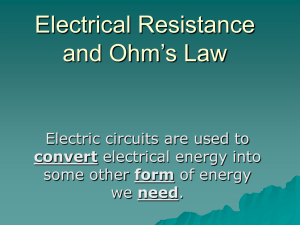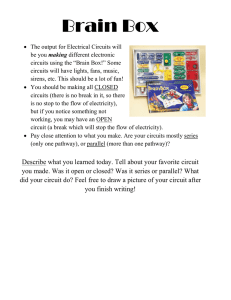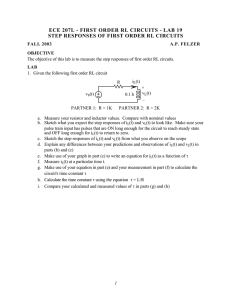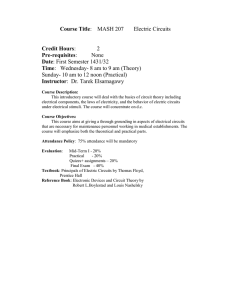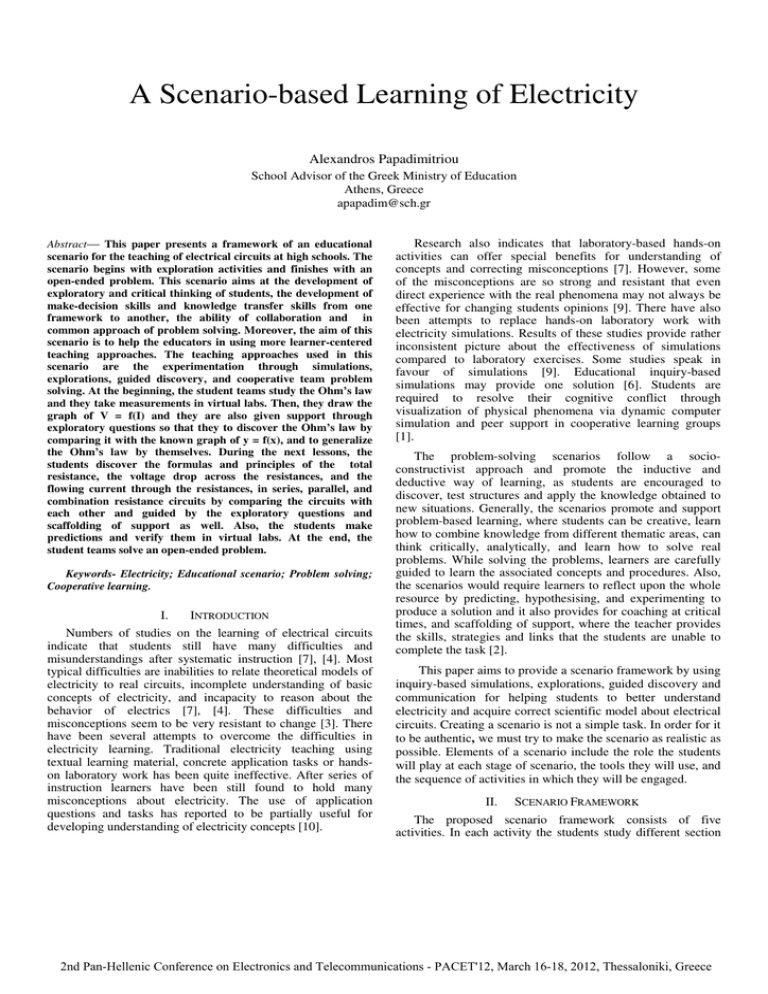
A Scenario-based Learning of Electricity
Alexandros Papadimitriou
School Advisor of the Greek Ministry of Education
Athens, Greece
apapadim@sch.gr
Abstract— This paper presents a framework of an educational
scenario for the teaching of electrical circuits at high schools. The
scenario begins with exploration activities and finishes with an
open-ended problem. This scenario aims at the development of
exploratory and critical thinking of students, the development of
make-decision skills and knowledge transfer skills from one
framework to another, the ability of collaboration and in
common approach of problem solving. Moreover, the aim of this
scenario is to help the educators in using more learner-centered
teaching approaches. The teaching approaches used in this
scenario are the experimentation through simulations,
explorations, guided discovery, and cooperative team problem
solving. At the beginning, the student teams study the Ohm’s law
and they take measurements in virtual labs. Then, they draw the
graph of V = f(I) and they are also given support through
exploratory questions so that they to discover the Ohm’s law by
comparing it with the known graph of y = f(x), and to generalize
the Ohm’s law by themselves. During the next lessons, the
students discover the formulas and principles of the total
resistance, the voltage drop across the resistances, and the
flowing current through the resistances, in series, parallel, and
combination resistance circuits by comparing the circuits with
each other and guided by the exploratory questions and
scaffolding of support as well. Also, the students make
predictions and verify them in virtual labs. At the end, the
student teams solve an open-ended problem.
Keywords- Electricity; Educational scenario; Problem solving;
Cooperative learning.
I.
INTRODUCTION
Numbers of studies on the learning of electrical circuits
indicate that students still have many difficulties and
misunderstandings after systematic instruction [7], [4]. Most
typical difficulties are inabilities to relate theoretical models of
electricity to real circuits, incomplete understanding of basic
concepts of electricity, and incapacity to reason about the
behavior of electrics [7], [4]. These difficulties and
misconceptions seem to be very resistant to change [3]. There
have been several attempts to overcome the difficulties in
electricity learning. Traditional electricity teaching using
textual learning material, concrete application tasks or handson laboratory work has been quite ineffective. After series of
instruction learners have been still found to hold many
misconceptions about electricity. The use of application
questions and tasks has reported to be partially useful for
developing understanding of electricity concepts [10].
Research also indicates that laboratory-based hands-on
activities can offer special benefits for understanding of
concepts and correcting misconceptions [7]. However, some
of the misconceptions are so strong and resistant that even
direct experience with the real phenomena may not always be
effective for changing students opinions [9]. There have also
been attempts to replace hands-on laboratory work with
electricity simulations. Results of these studies provide rather
inconsistent picture about the effectiveness of simulations
compared to laboratory exercises. Some studies speak in
favour of simulations [9]. Educational inquiry-based
simulations may provide one solution [6]. Students are
required to resolve their cognitive conflict through
visualization of physical phenomena via dynamic computer
simulation and peer support in cooperative learning groups
[1].
The problem-solving scenarios follow a socioconstructivist approach and promote the inductive and
deductive way of learning, as students are encouraged to
discover, test structures and apply the knowledge obtained to
new situations. Generally, the scenarios promote and support
problem-based learning, where students can be creative, learn
how to combine knowledge from different thematic areas, can
think critically, analytically, and learn how to solve real
problems. While solving the problems, learners are carefully
guided to learn the associated concepts and procedures. Also,
the scenarios would require learners to reflect upon the whole
resource by predicting, hypothesising, and experimenting to
produce a solution and it also provides for coaching at critical
times, and scaffolding of support, where the teacher provides
the skills, strategies and links that the students are unable to
complete the task [2].
This paper aims to provide a scenario framework by using
inquiry-based simulations, explorations, guided discovery and
communication for helping students to better understand
electricity and acquire correct scientific model about electrical
circuits. Creating a scenario is not a simple task. In order for it
to be authentic, we must try to make the scenario as realistic as
possible. Elements of a scenario include the role the students
will play at each stage of scenario, the tools they will use, and
the sequence of activities in which they will be engaged.
II.
SCENARIO FRAMEWORK
The proposed scenario framework consists of five
activities. In each activity the students study different section
2nd Pan-Hellenic Conference on Electronics and Telecommunications - PACET'12, March 16-18, 2012, Thessaloniki, Greece
of electric circuits. This scenario may be taught in
interdisciplinary instruction by the engagement of
Mathematicians, Physicians, and Electrical or Electronic
Engineers. Team-teaching may be the most obvious way of
getting interdisciplinary instruction into the classroom. Student
learning outcomes expressed at all six levels of Bloom's
taxonomy become the foundation for the selection and design
of assignments, teaching strategies, and instructional materials
such as simulations based on the CircuitMaker software.
As I mentioned above, the scenario uses inquiry-based
simulations,
explorations,
guided
discovery,
and
communication. Through a process of inquiry, the empirical
evidence is transformed (e.g., natural phenomena) into revised
and new knowledge structures. Students actively construct
knowledge by designing experiments, making observations,
proposing hypotheses, solving problems, answering
questions, gathering and analyzing data, synthesizing,
comparing, creating explanations, and communicating.
The scenario may last up to five didactic hours. The
curriculum area and pedagogic activities of the scenario are
the following:
A. Curiculum Area
1) Subject/discipline area : Physics education; Electric
circuits for Technical High Schools.
2) Context/level of study: Senior High School or Technical
High School. The scenario is implemented in the penultimate
grade of the high School; students are 16-18 years old.
Topic/domain: Simple Electric Circuits (it includes the
following subchapters: 1. Ohm’s law, 2. Series Circuits, 3.
Parallel circuits 4. Series-Parallel combination circuits).
3) Pre-requisite skills/ knowledge: They must know to
solve simple mathematical equations in the form of ay+bx = c
and draw graphs.
The worksheets of the activities were created based on the
following National Science Education Standards [8]:
a.
the material provides a sequence of learning activities
connected in such a way as to help students build
abilities of inquiry, understandings of inquiry, and/or
fundamental science subject matter concepts, and
specific means (e.g., connections among activities,
linkage between text and activities, building from
concrete to abstract, and embedded assessments) to
help the teacher keep students focused on the purpose
of the lesson;
b.
the teacher’s guide present common student difficulties
in learning inquiry abilities and understandings;
c.
there are suggestions provided to access prior abilities
and understandings of students;
d.
opportunities for students are given to demonstrate the
same understandings as part of their investigations.
The instructor monitors the progress of the teams and
provide assistance only when requested. Students are
encouraged to discover concepts and formulas through
experimentations, observations and inquires, and in turn use
what they discovered to solve challenging problems.
III.
ACTIVITIES OF THE SCENARIO
B. Pedagogic Activities
General Directions: You will need the CircuitMaker
software for these assignments. Use the guides of the
worksheets to answer the questions. Observe the
experimentations and save your experimental findings in your
notebook so that you can use that information for drawing the
graph, analyzing them, etc. Use scientific criteria to analyze
alternative explanations and develop a preferred explanation.
Discuss with your partners of both roles and limitations of
skills such as organizing and interpreting data, and
constructing explanations. You should work in teams of three
(recommended) or four members.
1) Learning tasks/ activities: Teacher initiates students to
what he/she is going to teach through an introductory
discussion. He/ She uses the CircuitMaker software and five
organized activities.
2) Learning objectives/ outcomes: Learn about operational
differences between series, parallel, and combination circuits;
learn to predict outcomes and draw conclusions; learn about
teamwork and working in teams; learn that different circuit
designs result in different electrical behaviours; Raise
learners’ interest towards the electric circuit investigation and
discovery principles and concepts through explorations,
inquiry-based simulations and guided discovery; after testing
several predictions about each circuit type, the teams will
compare results and discuss findings; in general, students learn
how to learn.
3) Tools/Resources:
Traditional
course
book,
CircuitMaker software, worksheets of activities, Whiteboard.
4) Assessment Strategy (Feedback and/or Evidence): Oral
questioning and discussion between student teams and teacher.
5) Time allocated: Up to five didactic hours.
A. Activity 1
Title: Ohm’s law
Lesson Focus: Discovery of Ohm’s law by using inductive
reasoning.
Lesson Synopsis: This activity encourages student teams to
experiment, observe, make tentative hypothesis, gather and
interpret data as well as to use the data in drawing graphs, and
formulate the theory of Ohm’s law by using inductive
reasoning.
Prerequisites: Concepts of Voltage, Current, and Resistance,
graph of linear equation, and knowing of inductive reasoning.
Worksheet 1:
1. Make the following simulation of Fig. 1 in the
CircuitMaker software, vary the value of the voltage of
the source Vs1 from 0 to 10, complete the Table 1, and
answer the questions below.
Exploratory Questions
a. Do the values of the quantities V and I of the Table 1
vary in a linear way? If yes, what kind of mathematical
equation is it?
Figure 1. Simple electric circuit
TABLE 1: ACTIVITY 1
V [DC V]
0
1
2
3
4
5
6
7
8
9
10
I [DC A]
b.
Draw a graph next to the graph of linear equation of
the Fig. 2 by using your measurements on the Table 1,
and answer the questions below.
Exploratory Questions
a. Are the graphs similar? (examine if the graphs have the
same tan).
b.
Which is the relationship between the voltage (V),
current (I) and resistance (R) for the values of
resistance 5, 10, and 25 Ohm?
c.
Use inductive reasoning to generalize the relationship
between the voltage (V), current (I) and resistance
(R). This law of the simple electric circuit is the
Ohm’s Law.
B. Activity 2
Title: Series circuits
Lesson Focus: Discovery of formulas and principles of series
circuits.
Lesson Synopsis: This activity encourages students to test
two different circuit designs (a simple electric circuit versus a
serial circuit). Students work in teams to predict the difference
between the two circuit designs by comparing them
(similarities, differences) in order to discover the principles,
and formulas of the new circuit.
Prerequisites: Ohm’s law.
Worksheet 2
1. Make the following simulations of Fig. 3 (the circuits A
and B).
2. Make predictions about the values of Is1, VR1, Is2, VR2,
and VR3 if the values of both the voltages Vs1 and Vs2
are10V.
3. Vary the value of the voltage of the sources Vs1 and Vs2
from 0 to 10, complete the Table 2, and answer the
questions below.
Circuit A
Circuit B
b. If the tan is the same in both of graphs, which is the
relation between the resistance R and A (= tan )? (the
value of the resistance R is 10Ohm).
Graph of Linear equation
y = 10 · x
y
10
10
8
8
6
6
4
Figure 3. Camparing two electric circuits
4
= tan
2
0
: students’ possible measurements
V
0
0,2
0,4
0,6
? = tan
2
0,8
y
Α = tan θ = = 10
x
1,0 x
0
0
0,2
0,4
0,6
? = tanθ
0,8
1,0
I
V
= =?
I
Figure 2. Examination if the two graphs have the same tan
3.
A tentative hypothesis is that the R= tan is applied for all
values of the resistance R. Repeat the steps 1 and 2 for the
following values of the resistance R: 5 Ohm, and 25 Ohm,
and answer the questions below.
Exploratory Questions
a. Is the resistance R equal to tan in all three graphs?
Exploratory Questions
a. For the same voltage of the sources Vs1 and Vs2, of
the two circuits A and B, do you observe the same
current Is1 and Is2, respectively? If yes, what can we
conclude about the total (or equivalent) resistance of
the circuit B? Which is the formula calculating the
total resistance in series circuits?
b. Use inductive reasoning to generalize the formula of
the total resistance in series circuits with more than
two resistances.
c. For each value of the voltage of the source Vs2 which
is the sum of VR2 (voltage drop across the resistance
R2) and VR3 (voltage drop across the resistance R3)?
What can we conclude about the relationship among
the voltages Vs2, VR2, and VR3?
TABLE II.
ACTIVITY 2
Vs1
0
1
2
3
4
5
6
7
8
9
10
Is1
VR1
Vs2
0
1
2
3
4
5
6
7
8
9
10
Is2
Is2*R2
Is2*R3
VR2
VR3
d.
Use inductive reasoning to generalize the equation
connecting the voltage Vs2 with the voltage drops
VR2 and VR3 across the resistances R2 and R3,
respectively, in series circuits with more than two
resistances.
e. Compare (examine) the relationship between the
Is2*R2 and VR2 as well as between the Is2*R3 and
VR3. What can we conclude about this comparison?
How to calculate the voltage drop across series
resistors?
f. Use inductive reasoning to generalize the formula
calculating the voltage drop across series resistances
in series circuits with more than two resistances.
Activities 3 and 4 are structured at the same way with the
Activity 2. For the economy of the space of paper these
activities are not presented in this paper.
C. Activity 5
Title: Open-ended problem about electrical circuits.
Lesson Focus: Students use the knowledge about electrical
circuits, obtained until now, to solve an open-ended problem.
Also, they should be able to restrict the number of solutions of
the problem.
Lesson Synopsis: This activity encourages students to solve
open-ended problems by dividing them into sub-problems.
The decisions needed to solve a problem arisen from choosing
sub-problems [5].
Prerequisites: Series, Parallel, and Combination circuits.
Recommendation: This activity should be better to be taught
by using the brainstorming technique.
Worksheet 5
Problem definition: How many ways can we connect the
resistances R1=2Ohm, R2=3Ohm and R3=6Ohm?
Problem restrictions: In order to restrict the number of
solutions of the problem we should modify the problem so that
to give the lower limit of solutions. In your opinion, which of
the modifications below may assist you to restrict the number
of solutions of the problem to the lower limit?
a. How many ways can we connect the resistances
R1=2Ohm, R2=3Ohm, and R3=6Ohm so that each of the
possible connections to give the same total resistance?
b. How many ways can we connect the resistances
R1=2Ohm, R2=3Ohm, and R3=6Ohm so that each of the
possible connections to give different total resistance?
c. How many ways can we connect the resistances
R1=2Ohm, R2=3Ohm, and R3=6Ohm so that each of the
possible connections to give only one value to the total
resistance?
Division of the problem into sub-problems: For the case b
of the above modifications divide the problem into four subproblems. For example, one sub-problem should examine the
solutions of series circuits. In this case, you should find out the
possible solutions before and after the restrictions.
Decision making and criteria judging the best solutions:
For the case b of the above modifications of the initial
problem, the criteria for judging which solutions best solve the
problem are the following:
Sub-problem1: For series resistances it should be possible to
give one only solution among equivalent possible solutions
(weight=25%).
Sub-problem2:For parallel resistances it should be possible to
give one only solution among equivalent possible solutions
(weight=25%).
Sub-problem3:For two series resistances in parallel with the
third one, it should be possible to give three solutions among
equivalent possible solutions (weight=25%).
Sub-problem4:For two parallel resistances in series with the
third one, it should be possible to give three solutions among
equivalent possible solutions (weight=25%).
The idea with the highest score will best solve the
problem.
REFERENCES
[1]
Abdullah, S. and Shariff, A. “The effects of inquire-based computer
simulation with cooperative learning on scientific thinking and
conceptual understanding of gas laws”. Eurasia Journal of Mathematics,
Science and Technology Education, vol. 4, no. 4, pp. 387-398, 2008.
[2] Carroll M. J., “Five Reasons for Scenario-based Design”, Proceedings of
the 32nd Hawaii International Conference on System Sciences, pp. 3.
1999.
[3] Chi, M.T.H. “Three types of conceptual change: Belief revision, mental
model transformation, and categorical shift.” In S. Vosniadou (Ed.),
Handbook of research on conceptual change, 2008, pp. 61-82. Hillsdale,
NJ: Erlbaum.
[4] Duit, R. & von Rhöneck, C. “Learning and understanding key concepts
of electricity”. In A. Tiberghien, E.J. Jossem & J. Barajos (Eds.)
Connecting research in physics education with teacher education.
International commission on physics education, 1998.
[5] Gök, T. A new approach: Computer-assisted problem-solving systems.
Asia-Pacific Forum on Science Learning and Teaching, vol. 11, no. 2,
2010.
[6] Hung, D. & Chen, D. “Two kinds of scaffolding: The dialectical process
within the authenticity-generalizability (A-G) continuum”. Education
Technology & Society, vol. 5, no. 4, pp. 148-153, 2002.
[7] McDermott, L. & Shaffer, P. “Research as a guide for curriculum
development: An example from introductory electricity.” American
journal of physics, vol. 60, no. 11, pp. 994-1013. 1992.
[8] Olson, S. and Loucks-Horsley, S. (Eds). “Inquiry and the National
Science Education Standards: A Guide for Teaching and Learning”.
2000. Copyright © National Academy of Sciences. All rights reserved.
[9] Ronen, M. & Eliahu, M. “Simulation. A bridge between theory and
reality: The case of electric circuits”. Journal of computer assisted
learning, vol. 16, pp. 14-26, 2000.
[10] Wang, T. & Andre, T. Conceptual change text versus traditional text and
application questions versus no questions in learning about electricity.
Contemporary educational psychology, vol. 16, pp. 103-116, 1991.

